For SEOs that lack the necessary experience, trying to optimize a website for users speaking different languages or located in different countries can be an overwhelming task. This in-depth guide on international SEO is was created to support them in the process.
I am first going to briefly explain what international SEO is and when it is necessary. I will then provide lots of technical tips on how to optimize sites, including which URL structure to choose, how to set up geotargeting in the Google Search Console and Bing Webmaster Tools, and also how to properly implement language tags.
What Is International SEO?
Simply put, international SEO helps you to optimize your website for search engines, so they can better understand what countries and languages you have created the various pieces of content on your website for.
This information is then used to improve the quality of search results by serving the most relevant content to each individual audience
When Is It Important?
International SEO becomes important when you have a website that is either multilingual, which means that it offers the same content in at least two different languages or regional accents, when it is multi-regional, meaning that you serve different content to users located in different countries or both.
An example for a multilingual website would be the web presence of a car rental company in Canada that provides two identical versions of the site - one is written in English and one in French.
An example for a multi-regional website would be if a Canadian car rental company also does business in Mexico. And let's say, as an example, that Mexicans prefer to rent smaller cars with less horsepower and at lower costs. The website version for Mexico is not just a mere translation of the original English content into the Spanish language; the content itself has changed. So we have slightly different branding, different rental cars with different product images and descriptions, different prices and, of course, a different currency.
The First Step
Finding the best possible solution for your business in regards to international SEO depends first and foremost on your business goals.
Therefore, you first have to define which users you want to target. You can do that by asking yourself the following three questions:
Do I want to target users speaking a certain language? Then you have to apply language targeting. Do I want to target users in a specific country and therefore, I am going to create content customized to them? Then you have to focus on geotargeting. Do I want both? It looks like you have to do both language targeting and geotargeting.Technical Tips On International SEO
You now know if you need to apply geotargeting, language targeting or a combination of the two. Let's start to take a look at the technical side of things.
There are two main problems in regards to international SEO:
How to structure the different versions of content on your site or sites. How to tell search engines which version of the content is best suited for which audience.Cookies & Scripts
First of all, you definitely don't want to use cookies or JavaScript to show different country or language-specific versions of your website on the same URL.
This will possibly prevent all site versions but one to get crawled and indexed in the search engines, so make sure to stay away from that.
IP Address & Browser Based Redirects
Some webmasters don't want to bother their users. So they auto-redirect them to what they believe is the most relevant language/location-specific version of content based on the detected IP address or browser settings. The goal: Improving user experience.
However, this approach poses a number of problems:
Inaccuracy - IP addresses can be highly inaccurate. It might happen that you mislocate a user and force redirect him to an irrelevant part of your website. Incomplete Indexation - The Googlebot crawls from an IP address based in California, so it will only ever see the version dedicated to the U.S. Multiple Countries - A language can be spoken in multiple countries. Which country do you choose? Multiple Languages - A country can have multiple official languages. Which language do you choose? Slow - Additional redirects add to the amount of time that a user has to wait before he gets full access to your site.This is why we recommend you ask your users when visiting your website for the first time, to select their country of residence and/or their favorite language and then set cookies accordingly.
URL Structures: ccTLDs vs. Subdomains vs. Subfolders vs. Parameters
It is important to establish a URL structure that does not only make sense from a human perspective but is also logical and therefore easy to comprehend for crawlers.
You have multiple options here, and there are advantages and disadvantages that come with each.
For example: On the one side, there are the search engines that favor country specific domains. On the other side is your developer team which is probably looking for the most convenient way of doing things, so they prefer using subfolders.
There really is no one-size-fits-all solution here. The most important factor is that whichever URL structure you choose, you should stick with it throughout your whole internationalization efforts.
Also, changing your URL structure later on is not only a complicated process, but it is also likely to influence your rankings and cause a drop in traffic for a certain time period, so make sure to do all the necessary planning beforehand.
Here are your available options:
ccTLDs
If you want to focus on targeting a specific country, think about using a ccTLD (country code top-level domain).
ccTLDs are country-specific domains and both Google Search Console and Bing Webmaster Tools automatically geotarget a ccTLD to the assigned country.
Example:
yoursite.us → automatically targeting all users located in the U.S.
The bad news about ccTLDs is that since your site is primarily targeted to all the users but only the users located in a certain country, room for expansion is limited. Let me give you an example:
You have started out with a .fr domain (automatically targeted to France) with French content on it. Recently, you have created an English version of your site on a subdomain to target users in the UK, and you want to rank in Google.co.uk.
uk.yoursite.fr
You will probably have a hard time doing so because for Google a ccTLD is a strong indicator "that your site is explicitly intended for a certain country" ( source) and the same goes for Bing.
Is it impossible for you to rank in Google.co.uk? No, you can still do it, if your content is highly relevant for users in the UK and more relevant than local content, but it is not going to be easy.
By the way, an exception to this is when you have a ccTLD, and there are multiple languages spoken in that particular country - think Canada or India. In this case, we have a combination of both language and geotargeting.
gTLD With Subdomain
gTLDs (generic top-level domains) are domains that are not country-specific. Therefore, if you want to geotarget a gTLD to one country, you must do so manually in the Google Search Console and Bing Webmaster Tools.
Example:
yoursite.com
A subdomain defines a bigger part of the root domain and can be used to set up a blog, an e-Commerce store, etc., and also for language and geotargeting.
Example:
us.yoursite.com → to target all users located in the United States
gTLD With Subfolders
A subfolder defines a subsection of a domain or subdomain.
Example:
yoursite.com/us → to target all users located in the United States
gTLD With Parameters
By adding a language parameter, you can also target your content to users speaking a certain language.
Example:
yoursite.com?lang=en-us → to target all users that speak American English
For the sake of completeness, I want to mention location parameters in this guide, although they are not really an option and not recommended by Google to use for your URL structure for two reasons:
URL-based segmentation is difficult and can cause indexation issues. In the Google Search Console geotargeting with parameters is not possible.Example:
yoursite.com?loc=ca → to target all users in Canada
Combinations
If you want to apply language targeting and geotargeting at the same time, you will have to use combinations of the structures above. For example, you can combine a subdomain with a subfolder, or a subfolder with a parameter.
You can also use two subfolders in a row. In that case, you should always use the first subfolder for the country targeting and the second folder for the language targeting.
Here are a handful of examples of possible combinations for targeting French-speaking users in Canada:

URL Structures Pros & Cons
To help you choose the type of URL structure that best suits your business, I have summarized the pros and cons associated with each in the table below:
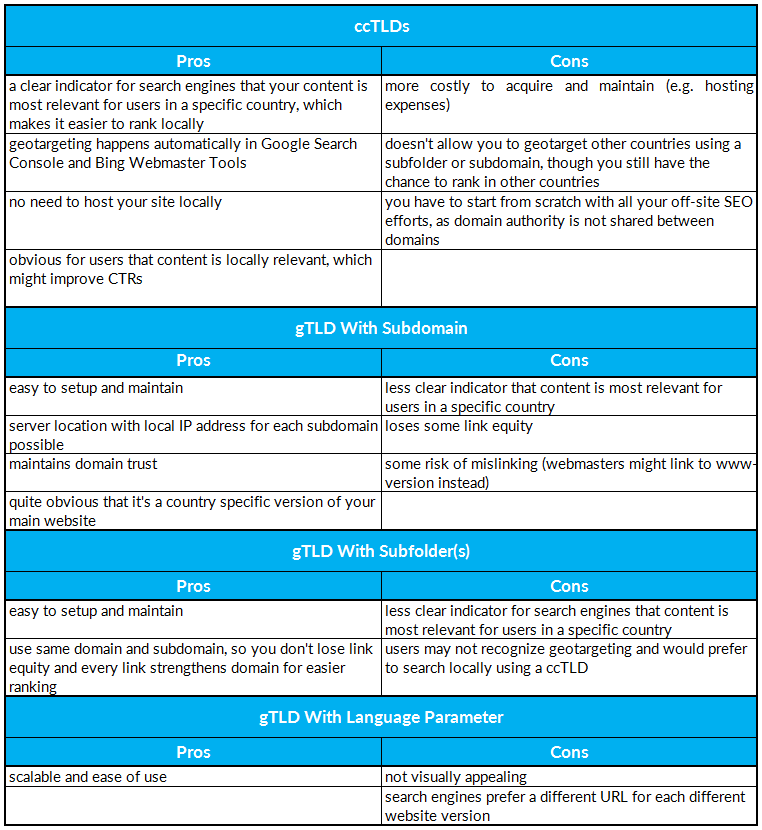
Bottom Line
To sum up, here are my recommendations for the different URL structures.
ccTLDs require the most resources to set up and maintain especially in regards to content and are therefore best suited for already well-known brands with large audiences in their target countries. Subfolders are best suited for businesses that have fewer resources and that want to keep their maintenance costs at a bare minimum. Also, in case you have a well-established website you can benefit from an already built-out link profile. Subdomains allow you to set up local servers in multiple countries. However, they come with downsides, and we generally prefer using ccTLDs or subfolders over subdomains. Language parameters are a scalable solution and easy for tagging. However, they don't look as clean.Geotargeting
If you want to expand your business into another country and you are going to create entirely new content for your new users, geotargeting is your way to go.
You can use geotargeting to tell search engines which of your domains, subdomains or subfolders is most relevant for the residents of a particular country.
But I really want to emphasize that it is very important that your new content differs from the old in a sense that you are not just translating words into another language because then you would have to apply language targeting.
To what degree do you have to change your content, so it is not considered duplicate content? That is not an easy question to answer, as there's no clearly defined threshold. The general rule is: The more changes you make, the less likely it is that you will experience any issues.
Hosting
Does hosting your site on a local IP address give you any benefit in terms of search engine rankings and indexation?
According to Google, using a ccTLD makes hosting a site on a local server completely irrelevant. For gTLDs, server location can be a signal for your site’s intended audience, which comes in handy when you use subdomains for geotargeting. Keep in mind that the further away the server is from your target audience, the longer it will take your site to load, which worsens user experience.Regional Targeting
Last but not least and before I am going to show you how to use geotargeting in Google Search Console and Bing Webmaster Tools, I want to address a common misconception:
Some SEOs believe that you can geotarget cross-national to a whole region such as Europe. Unfortunately, that is not the case. Right now you can only implement country-specific geotargeting, and regional TLDs such as .eu are treated as generic TLDs.
How To Implement Geotargeting
In the Google Search Console, you have to claim each domain, subdomain or subfolder one at a time and specify which country you want to target.
Fortunately, with Bing Webmaster Tools the whole process is a lot more convenient, as there is no need to verify each section you want to edit separately, which saves us quite a bit of work.
Here is how you do it:
In Google Search Console
On the homepage of your dashboard click on "ADD A PROPERTY" and separately claim ownership of each domain and subfolder you want to configure. To geotarget a property to a specific country, click on the property in your dashboard. Next click on "Search Traffic" in the left sidebar. Then click "International Targeting" in the drop-down menu. On the International Targeting page click on the "Country"-tab at the top, check the box next to where it says "Target users in", and finally choose the country which you want to target with your property and hit "Save".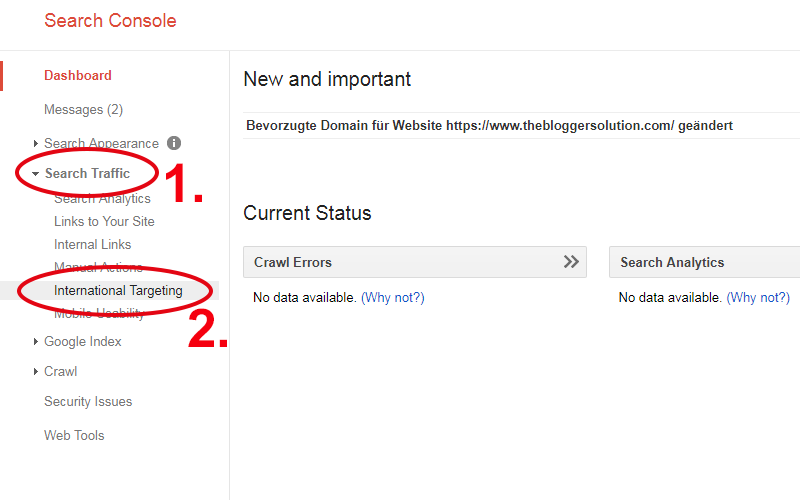
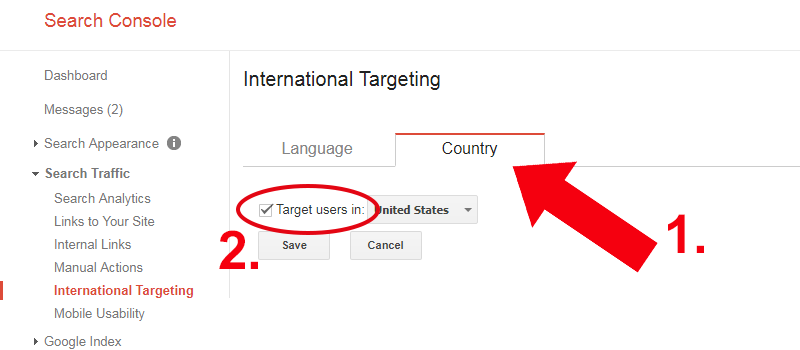
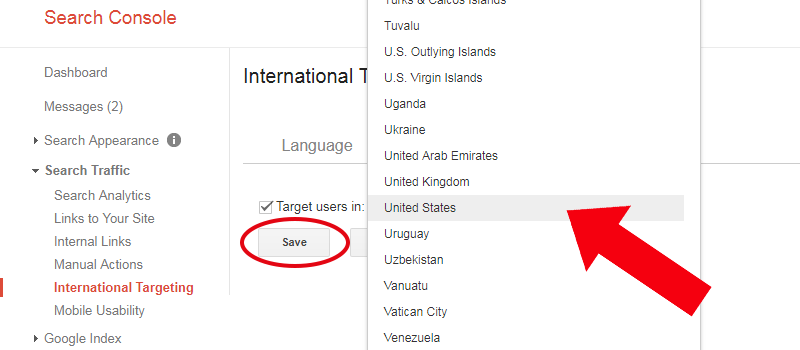
And that is already it! All you have to do now is repeat step 2 to 4 for each property.
In Bing Webmaster Tools
As stated before, Bing Webmaster Tools allows you to define a country audience for your entire website or for sections of that site by claiming the domain as a whole.
In your dashboard, start by click on the web property you want to edit. Then click on "Configure My Site" in the sidebar on the left. Next click on "Geotargeting" in the drop-down menu. Now choose either "Domain", "Subdomain" or "Directory" from the drop-down menu at the top. Finally, enter your URL, choose the country you want to target and hit "SUBMIT".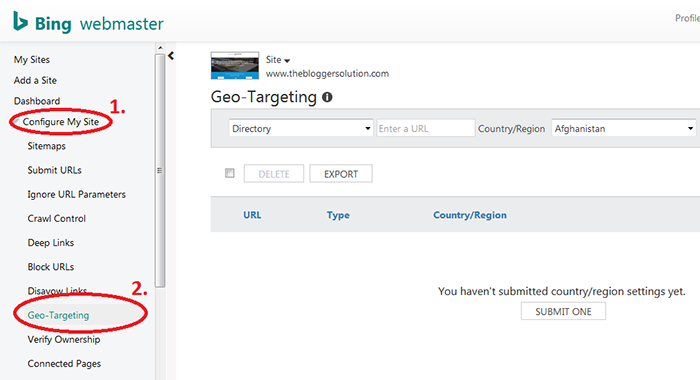

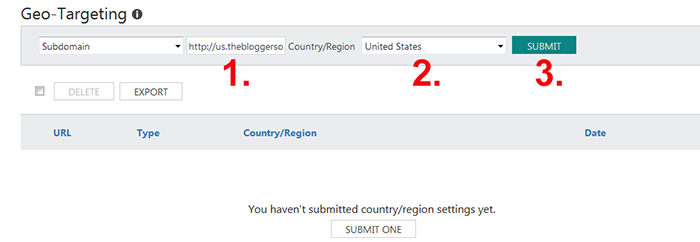
Again, rinse and repeat the whole process for all domains and subfolders.
By the way, with Bing Webmaster Tools you can even geotarget single pages of your ccTLD to a specific country other than the one your domain is automatically associated with. This can be useful, e.g. in case you have created specific landing pages for users from different countries.
Hreflang With Geotargeting
Does it make sense to use hreflang for geotargeting?
No, it doesn't, because when using geotargeting only, hreflang should not be needed, as you intend to create new, country-specific content, which is not a translation of the content that you already have on one of your other sites.
However, it is possible that some of your new pages are identical to some of the old pages, maybe because you want to offer the same couple of products in two different locations. In this case, setting language tags for those pages is mandatory.
Language Targeting
Language targeting allows you to tell search engines which of your domains, subdomains, subfolders or site parameters is the most relevant for users speaking a particular language.
In terms of international SEO, language targeting is the best solution, if user location does not influence the content of your website, but the language that the content is presented in.
At first glance, language targeting seems to require a lot less effort than geotargeting, as you don't have to come up with new content. All you have to do is to translate your already existing web copy into whatever language you are shooting for and set language tags for Google and Bing accordingly.
The big problem, however, with language tagging is that when done wrong, it is likely going to prevent search engines from properly indexing a majority of your content. This can have a big impact on your traffic and the UX.
Just imagine for a second what would happen with your e-Commerce store revenue, if all of a sudden Google would direct all the English-speaking users to the Spanish version of your website. That would be disastrous!
Google's Hreflang
Introduced in 2010, Google's hreflang attribute can be used to indicate that there is an alternative version of a specific page on your site available that was translated into another language or a country-based language variation (regional dialect).
Google uses this information to serve your content in the most relevant language based on a user's location and language preferences in the search results. Is this going to increase your traffic? No, not necessarily. But it will likely help to improve the user experience and decrease bounce rates.
Please be aware: The hreflang attribute is a signal but not a directive. This means that it is still possible for a different copy of your page to rank higher in the SERPs, although its language is less relevant.
Example:
For https://www.yoursite.com/ the following code points out to Google that a French version of the page can be found at the provided link:
<link rel="alternate" hreflang="fr" href="https://www.yoursite.com/fr/" /><link rel="alternate" hreflang="en" href="https://www.yoursite.com/" />
As you can see, you always have to include a reference to the page itself.
What's more, if https://www.yoursite.com/ links to https://www.yoursite.com/fr, then https://www.yoursite.com/fr also has to link back to https://www.yoursite.com/. If that is not the case, errors might occur.
If there is more than one translated copy of a page, make sure to reference each one of them, so:
<link rel="alternate" hreflang="fr" href="https://www.yoursite.com/fr/" /><link rel="alternate" hreflang="es" href="https://www.yoursite.com/es/" />
<link rel="alternate" hreflang="de" href="https://www.yoursite.com/de/" />
<link rel="alternate" hreflang="en" href="https://www.yoursite.com/" />
To restrict a page to a specific region, e.g., English speaking users in the United States or those living in the UK, you can extend the hreflang attribute by adding a country.
If you do this, Google recommends you to also specify a general language version for all the other users worldwide that are not located in one of the specified countries.
Example:
<link rel="alternate" hreflang="es-gb" href="https://www.yoursite.com/uk/" /><link rel="alternate" hreflang="en-us" href="https://www.yoursite.com/us/" />
<link rel="alternate" hreflang="en" href="https://www.yoursite.com/" />
As you can tell from the last example, the correct country code for the United Kingdom is not "uk" but "gb". So, using the appropriate code is not always intuitive, which is why it is important that you double check with ISO 639-1 for language codes and ISO 3166-1 Alpha 2 for region codes to avoid mistakes.
When does the differentiation between country-based language variations become useful? For example when words are spelled differently (color vs. colour) or if you have different currencies.
X-Default
A very common tagging mistake is using x-default inappropriately. The purpose of the tag is not to identify the "original", non-translated page so to speak. Rather, the purpose of it is to identify untargeted pages, such as your homepage, which lets the user select his or her favorite language and then redirects the user to the relevant section on your website.
X-default can also be used for pages that serve content in different languages dynamically.
This is what using the x-default looks like:
<link rel="alternate" href="https://www.yoursite.com/" hreflang="x-default" />Implementation - Sitemaps vs. HTTP Headers vs. On-Page Markup
The hreflang attribute can be placed in sitemaps, HTTP headers or in the on-page markup. You should choose the method that is easiest for you to maintain and update.
Whichever option you choose, make sure to only ever use one of the locations.
Sitemaps
Placing hreflang in your XML sitemaps is convenient and allows to keep the tagging off the pages and thereby reduces the amount of code on each page, which in turn improves load times.
However, depending on the size of your site it might happen that your sitemap ends up too large. In that case, you can create multiple sitemaps, one for each language/country version of your website.
When using a sitemap for language tagging, specify the xhtml namespace as follows:
xmlns:xhtml="http://www.w3.org/1999/xhtml"Then, for each URL create a separate URL element including a loc tag and an xhtml:link rel="alternate" hreflang="xx" subelement for every page copy and the page itself:
<?xml version="1.0" encoding="UTF-8"?> <urlset xmlns="http://www.sitemaps.org/schemas/sitemap/0.9" xmlns:xhtml="http://www.w3.org/1999/xhtml"> <url> <loc>https://www.yoursite.com/</loc> <xhtml:link rel="alternate" hreflang="fr" href="https://www.yoursite.com/fr/" /> <xhtml:link rel="alternate" hreflang="en" href="https://www.yoursite.com/" /> </url> <url> <loc>https://www.yoursite.com/fr/</loc> <xhtml:link rel="alternate" hreflang="en" href="https://www.yoursite.com/" /> <xhtml:link rel="alternate" hreflang="fr" href="https://www.yoursite.com/fr/" /> </url> </urlset>On-Page Markup
For on-page markup, use hreflang as a link attribute in the <head> section of your pages as demonstrated above.
HTTP Headers
In case you want to publish non-HTML files, you can use an HTTP header to reference a different language version like this:
Link: <https://www.yoursite.com/fr/>; rel="alternate"; hreflang="fr"To indicate more than one language translation, separate the values with commas:
Link: <https://www.yoursite.com/fr/>; rel="alternate"; hreflang="fr",<https://www.yoursite.com/de/>; rel="alternate"; hreflang="de"Checking For Tagging Issues
Once your language tags are in place, use the Google Search Console to identify possible errors. The console also tells you how many hreflang tags were found in total.
Language Tagging With Canonical URLs
With the help of canonical tags, you can tell search engines that there is a page on your site that is accessible via more than one URL or that there are different pages which are almost identical.
The tag helps you to prevent duplicate content issues and allows you to signal which URL is authoritative for a page that you want to have appear in the search results. Using canonical tags is also important to consolidate link signals for easier rankings.
For example:
<link rel="canonical" href="https://www.yoursite.com/page-A />The canonical tag signals that the page the tag is implemented on is a duplicate of page A, which can be found at the provided link.
When To Use Canonicals With Language Tagging
You should not include canonical URLs across different language or country-specific versions of your site, but only within that language or country version. rel="alternate" hreflang should only be included on canonical URLs, not the duplicates. On the canonical URL use the hreflang attribute to refer to the corresponding canonical language equivalent.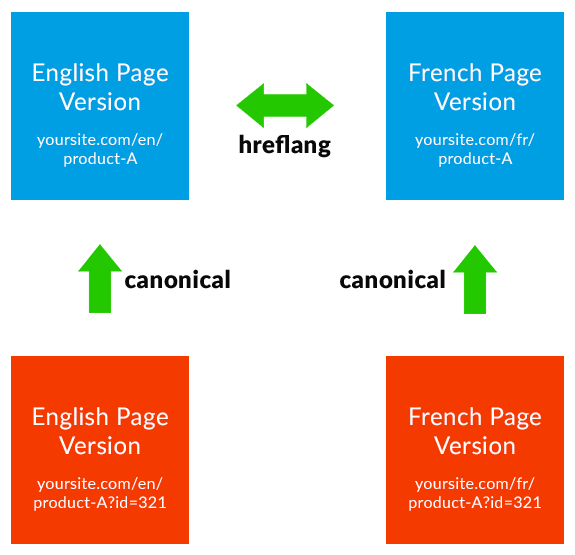
Bing's Language Meta Tag
Bing's version of the rel="alternate" hreflang attribute is the "content-language" Meta Tag.
As the name suggests, you can use the tag to tell Bing what the country-based language version of a page is.
Example:
<meta http-equiv="content-language" content="en-us">This tag would be appropriate for sites with content written in American English. By the way, you also have to refer to ISO 639 for language codes and ISO 3166 for region codes.
The code has to be implemented in the <head> section of a document. Alternatively, you can use either the <html> or <title> element of a document to embed the code as follows:
<html lang="en-us">OR
<title lang="en-us">It is best practice to use only one of the available options.
Last but not least, you can also embed the tag using the “content-language” HTTP header for host-wide tagging.
Language Targeting + Geotargeting
If you want to target users in a specific country speaking a specific language, you have to use a combination of language targeting and geotargeting.
Example:
A subfolder of your already existing online store is geotargeted to the U.S. You now want to enter the Canadian market where you are going to sell products that are different from those you sell in the States, so you create new content on your site in two language versions, French and English.
Next, you are not only going to geotarget the new content to Canada but also language target the French version of it to the French-speaking population and the English version to the English-speaking people.
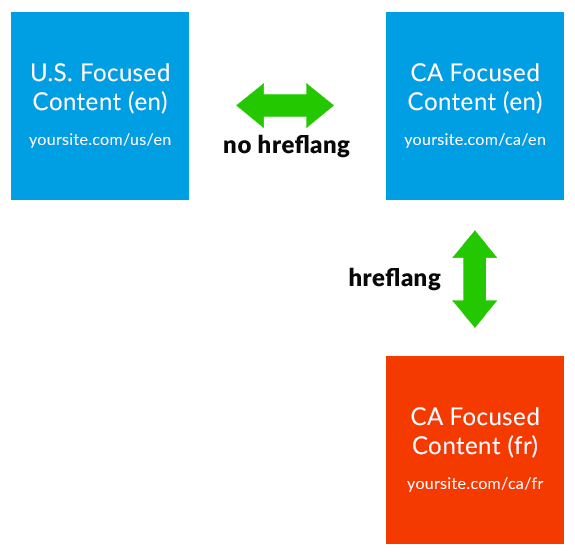
In Conclusion
I understand that optimizing a website internationally might seem too complicated at the beginning, but I promise you, as with many things in SEO, it gets easier over time and with a little bit of practice.
Remember that the most important step is to differentiate between language and geotargeting and know which one is for you. Then, choose the URL structure that best suits your needs and apply the different international SEO techniques - and needlessly to say, don't forget to monitor your rankings all the while!
Over to you.
[ create-campaign bg_images="https://static.semrush.com/blog/uploads/media/49/13/4913b5bc78d51cdbc61a26d4ae36268b/banner-885x180.png" ]
Sources:
https://moz.com/learn/seo/international-seo https://moz.com/blog/guide-to-international-seo https://www.advancedwebranking.com/blog/international-seo/ https://www.imarc.com/blog/url-structures-for-global-websites-and-seo https://support.google.com/webmasters/answer/189077?hl=en https://support.google.com/webmasters/answer/182192?hl=en https://blogs.bing.com/webmaster/2011/03/01/how-to-tell-bing-your-websites-country-and-language https://www.bing.com/webmaster/help/geo-targeting-your-website-b7629197Innovative SEO services
SEO is a patience game; no secret there. We`ll work with you to develop a Search strategy focused on producing increased traffic rankings in as early as 3-months.
A proven Allinclusive. SEO services for measuring, executing, and optimizing for Search Engine success. We say what we do and do what we say.
Our company as Semrush Agency Partner has designed a search engine optimization service that is both ethical and result-driven. We use the latest tools, strategies, and trends to help you move up in the search engines for the right keywords to get noticed by the right audience.
Today, you can schedule a Discovery call with us about your company needs.
Source:





